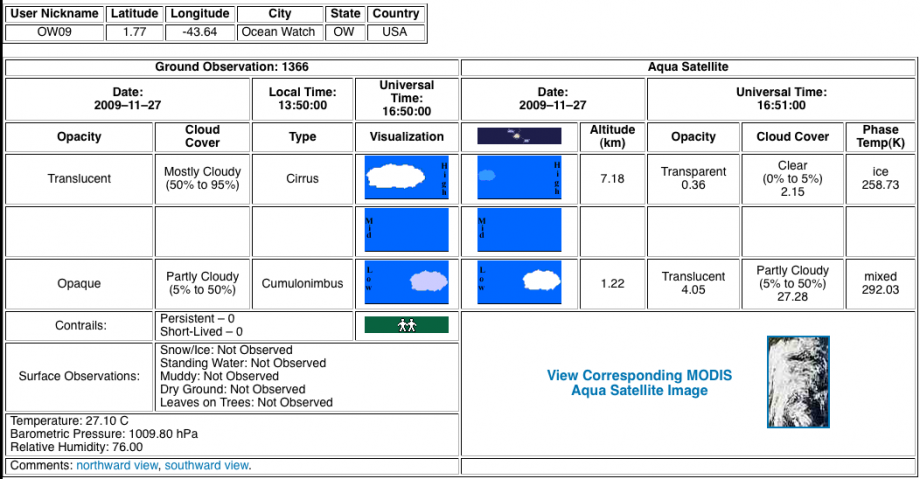guest blog by Dr. Jeff Goldstein, Science Educator and Planetary Scientist and Director of the National Center for Earth and Space Science Education, reprinted from Dr. Jeff’s Blog on the Universe, posted 13 June 2009, with permission of the author
“Daddy, how long is a billion years?”
As soon as we got in the car this morning, and buckled up, I said “so Jordi, I need some help. I need more material for the blog.” “Daddy, what do you mean by ‘material’?” “That’s what writers call the stuff they use to create stories”, said daddy.
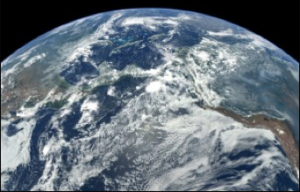
Earth from MESSENGER spacecraft as it flew by Earth on August 2, 2005. MESSENGER goes into orbit around Mercury on March 18, 2011.
It was a beautiful, sunny morning, so he started talking about … the Sun. He had lots of questions—where did it come from, what’s burning on it to make it so bright, how old is it, what will happen to Earth when it stops burning? The last one was particularly cool. I asked him if he thought the question “what will happen to the Earth when the Sun dies?” is something lots of kids might ask. He said “yes!!” I asked him who he thought was the first person to actually figure it out. He didn’t know. I told him it was me.
When I was a grad student at Penn, one of the undergrads in the class I was teaching asked that question. I didn’t know the answer, so I told her I’d find out. I tried but I couldn’t. Nobody had done it before. So I decided to be the first. I didn’t know if I could, and I didn’t know what I’d find, but it was incredibly exciting—and that’s science. Here’s the result. (And it was far from the end of the story.)
Jordi said, “YOU DID?” I looked at his surprised face in the rearview mirror and said “yup, your daddy.” Then he said, “that’s sooo strange! That’s sooo cool! I asked a question that YOU figured out!!” He was very proud. I felt so connected to him. (We’ll see later if he told his friends.) And I promise that I’ll make this story into a blog post, because now YOU’RE waiting for the rest of the story.
By the time we arrived at the school 20 minutes later, I had a month’s worth of ‘material’ for Driving with Jordi (stay tuned). The conversation was incredible. At one point though, Jordi ran into a conceptual wall when I was talking about the Sun’s lifetime being 10 billion years, and that it’s now half way through its life. He said “Daddy, how long is a billion years?”—which is why I wrote this post.
It is actually such an important question, and I thought about it all the way home. It’s at the heart of a key recurring problem in science education in that the VAST majority of humans truly don’t understand lengths of time that are far longer than our lifetimes. No wonder that folks don’t understand global warming as due to human intervention, and think it reasonable to interpret the data as explained by natural variation in the environment over long timescales. No wonder that folks don’t understand the timescales for evolution of species.
So here now is a novel way to look at it. Thanks Jordi! I think this will help lots of folks understand something they’ve never understood before.
Humans and Time
We humans now live on average about 75 years (in the developed world; in Africa the life expectancy is frighteningly low at 32 to 55). I’ll assume that 75 years is the life expectancy of a human in the absence of devastating diseases like AIDS, and with availability to modern medicine.
We humans also like to perceive the passage of time in units of seconds, minutes, hours, days, weeks, months, and years. We’ve created these units because they are comfortable, connected to the rhythms in the sky and in our bodies, and each is used to make sense of events both short and long. Here’s the critical point for the rest of the story—
One of our average humans sees 75 years x 365.25 days/year =27,394 days in their life
That’s amazing. That’s 27,394 days of getting up in the morning, eating, working, playing, relaxing, and going to bed. Put this way, the length of a single day is absolutely inconsequential relative to a human lifetime. Agreed? Good.
A Really Cool Diary
So let’s say I had this really cool diary with one page for every day of our average human’s life. It’s a single book with 27,394 pages. I could give it to you at birth and ask you to record your life one page—one day—at a time (with some help from a friend in your early and possibly later years). Like I said, one cool diary.
A Day in the Life of the Earth
Let’s say planet Earth was this large cosmic creature. She’s got a life expectancy of about 10 billion years, from her birth with the Sun nearly 5 billion years ago, to her ultimate fate when the Sun is in its waning years some 5 billion years from now (nope not telling).
Earth obviously has a lot to say, and SHE’s been keeping a diary since she was born. But she’s got it in far too many volumes, since each didn’t come with many pages, and they’re all old and worn out. Hey, I think a new diary is a perfect gift for her! I’ll give her one of my really cool diaries with 27,394 pages. I’ll help her move all her old diary entries into the new one so it will truly record her 10 billion year life. Why don’t we call each page a GEOLOGIC DAY (a Dr. Jeff made-up term.) And every Geologic Day is absolutely inconsequential relative to Earth’s lifetime. After all, Earth has 27,394 of them.
Every Geologic Day, Earth will write in her diary the comings and goings for that day. Here’s the next important point—
Every one of the 27,394 pages in Earth’s diary—each Geologic Day—is 365,000 years long.enough time for 14,600 human generations
How come? Easy: 10 billion years divided by 27,394.
Take a minute to process that.
I hope this gives you a new perspective for spans of time for Earth—called geologic time—relative to the time span for our fleeting lives.
So I give my friend the Earth one of my cool diaries. She likes it—her life all in one book. I also happen to be very close with Earth, and she’s letting me look at her diary. So here we are in the middle of her life and she just now finished her entry for day 13,697. She’s already written the first 13,696 pages (I helped her transfer the entries from her old diary with Apple Time Capsule.) Here now is her page 13,697—
Dear diary-
Today, as always, I’m going to keep a watchful eye across my surface. It’s an important responsibility being an oasis of life in a vast space. I’m very aware that all the countless forms of life living on me depend on a very delicate balance of surface conditions. Every Geologic Day, I hope I can avoid asteroids, comets, and super volcanoes, all examples of catastrophic events that have wreaked havoc with my sphere of life—my biosphere—in the past.
Today started out as pretty routine with lots of new things to see. I’m still watching those bipedal creatures that first appeared about 6 Geologic Days ago. Over the last few days, it looked like there were a few different species of them. But by late today I’m pretty sure there was only one dominant species left. I’m fascinated with them. They’re intelligent. They make tools.
Well, time to stop writing it’s just about the next Geologic Day. There’s only 35 Geologic Seconds left in this one (150 years to us humans). Wait … did you see that?! Carbon dioxide levels in my atmosphere just spiked! This just can’t be right! All of a sudden carbon dioxide is at the highest level it’s been in at least 2 Geologic Days (800,000 years) … maybe even 50 Geologic Days (20 million years)!
This is serious. Carbon dioxide might seem innocent enough—my diversity of life creates and uses it. But my neighbor Venus has an atmosphere that is 96% carbon dioxide, and while her surface should be about 125°F (50°C) at her distance from the Sun, the actual temperature is 880 °F (470 °C)—hot enough to melt lead. Carbon dioxide is a gas that induces a greenhouse effect on a planet, causing elevated surface temperatures, and in the case of Venus the effect is absolutely extreme. In my case, my biosphere is in a delicate balance, and even though carbon dioxide is a trace gas, a substantial percentage increase can cause dramatic changes in the environment.
IN AN ALMOST IMPERCEPTIBLY SMALL AMOUNT OF TIME—carbon dioxide in my atmosphere has skyrocketed by 60% over typical levels. Its increase is nothing short of—stunning. This is not due to natural cycles. No natural variation would happen this fast. This is the signature of a CATASTROPHIC EVENT. Some global scale, very short event that should be OBVIOUS. But I see no obvious crater, no super volcano … let me keep looking.
Wait. What’s happening now?! The temperature just spiked! Global temperature variation over the recent past shows “little ice ages” and warming trends, but what I’m seeing now is a SPIKE—a very quick change— that looks very different than those natural temperature variations. The global temperature is now CLEARLY INCREASING, and higher than it’s been recently (us humans currently have the ability to gauge it over the last 2,000 years), and it spiked at the same time as did the carbon dioxide.
This is very bad. Warnings are now coming in from everywhere—rapidly decreasing sea ice, rapid glacial melt. There has to be a cause. Something’s happened. Something’s different. This looks like the start of an irreversible change in the global environment. I’ve got to find out what’s happening before it’s too late for countless species on my surface. Let me keep looking and see if I can find something big that’s happened in this INSTANT in time … a trigger … something OBVIOUS.
Wait …. it’s … it’s the bipeds! OH NO … they’re everywhere! Their technology is EVERYWHERE—just in the last 35 Geologic Seconds! It’s an infestation!
They have got to be stopped. They’re supposed to be intelligent … maybe not. But I’ve got to try reasoning with them.
HEY YOU!! Look at the data!! Look at the data!! Quick! Quick!
What are you doing! Stop! Are you crazy?! Do you think you can load my atmosphere with those levels of emissions from your technology—in a blinding instant of time—and not impact me? Do you think my systems are capable of scrubbing the atmosphere that fast? MY SYSTEMS DON’T WORK ON TIMESCALES OF 35 GEOLOGIC SECONDS!!
…not enough of them are listening
They’re too busy, too pre-occupied … with themselves.
They don’t seem to care if they are committing suicide. Their choice. But … they don’t have the right to take countless other life forms with them. I’ve got to put in an emergency call to Interplanetary Pest Control, or … tomorrow will be a very bad day.
(Note to reader: spread the word on climate change. I’d argue you have a duty to spread the word. You should Tweet this one up planet-wide. And be moved to leave a comment.)
To Teachers:
You can really make this a powerful visual demonstration in class. The life of Earth recorded on 27,394 sheets of paper is a challenge to demonstrate. But if you can borrow some cartons of xerox paper, with each carton containing typically 10 reams, then here is what I’d do. Each ream contains 500 sheets. So you need 5 full cartons (that’s 50 reams = 25,000 sheets) + 4 reams (another 2,000 sheets) + 394 sheets.
Without telling the class anything about what you are doing, have them take the reams out of the boxes (without opening them) and lay them out on the floor. Have them open one ream to see how many sheets are in it. In fact, have them count the sheets in the ream and take out the 394 sheets you need. Then:
• walk them through the concept of a single diary for an average human lifetime: they should calculate how many diary pages they would need if there is one page per day; then have them calculate how many sheets are on the floor—”oh, the number of days in a human lifetime! WOW!! That’s a lot of days for a human!”
• let them in on the idea of giving this diary to Earth, and assuming a lifetime of 10 billion years, have them calculate how many years of history are on EACH sheet—”365.000 years! No way!!” Then have them calculate the equivalent number of human generations on one sheet assuming 25 years per generation (a reasonable time from parent birth to child of parent birth)—”Can that be right? 14,600 generations!?”
• re-arrange the paper with half of it on one side of the floor to represent Earth’s history that is already recorded,and the other half on the other side of the floor representing Earth’s future history.
• then pick the single sheet of paper that represents the last 365,000 years of history, so that on this sheet, the final diary entry is the present. Lay it between the two groups of paper representing the past and future history of Earth.
Ask the class to think about this sheet of paper as a 24-hour clock. So at time 0:00:00, you’re at the beginning of the sheet, 365,000 years ago. At time 12:00:00 you’re in the middle of the sheet 182,500 years ago. At time 24:00:00 you’re in the present moment, where you all happen to be sitting in class.
Ask them to calculate the time on the clock when human civilization began (10,000 years ago, answer: at time 23:20:19); when the industrial age began (the age of fossil fuels; 150 years ago, answer: at time 23:59:25).
Have them look at world population growth noting what’s happened during the age of fossil fuels, the carbon dioxide level over the last 650,000 years, and the world temperature over the last 2,000 years. What is the data telling you?
• have them figure out how many sheets ago the dinosaur extinction took place.
• have them research Earth’s geological history, and figure out which sheets contain other milestones or important intervals in Earth’s history.
This should be MIND BLOWING! It is an experience your students will likely remember for a lifetime.
* * *
Image courtesy NASA, Johns Hopkins University Applied Physics Laboratory, and Carnegie Institution of Washington.
From Dr. James Hansen, Director of the NASA Goddard Institute for Space Studies, concerning this post—Public understanding of climate change depends on an understanding of time scales. Goldstein [Dr. Jeff] does a brilliant job of making clear the rapidity of the human-made intervention in the climate system, and the correlation of global warming with the appearance of technology powered by fossil fuels.
Image courtesy NASA, Johns Hopkins University Applied Physics Laboratory, and Carnegie Institution of Washington.


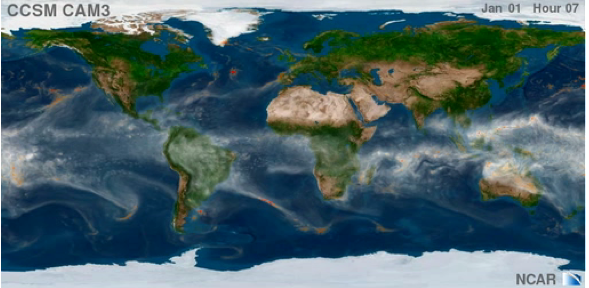
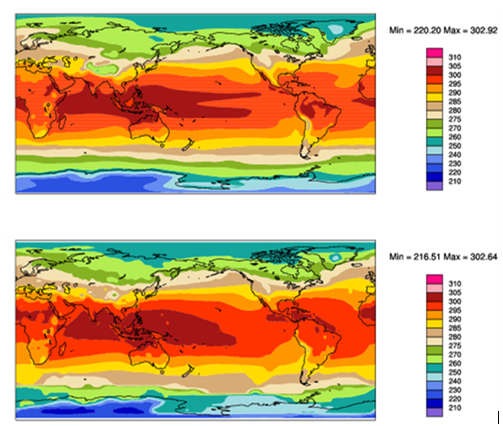
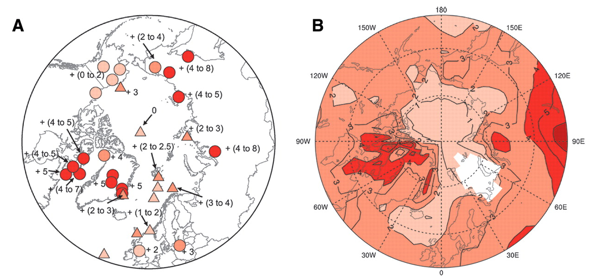
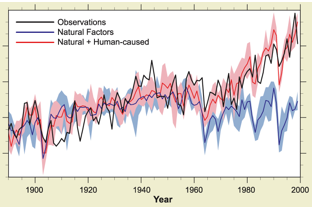
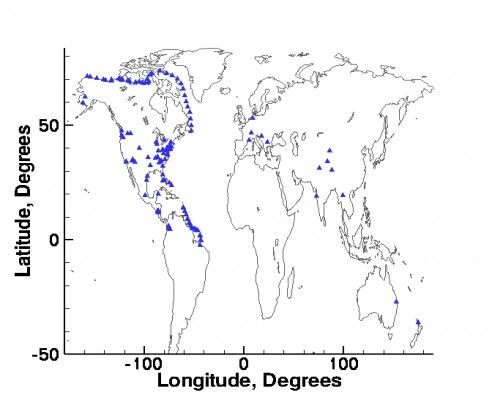 Pregunta a considerar: ¿Por qué se hallan los puntos del mapa más separados en el Paso del Noroeste y más juntos a lo largo de la costa de América del Sur?
Pregunta a considerar: ¿Por qué se hallan los puntos del mapa más separados en el Paso del Noroeste y más juntos a lo largo de la costa de América del Sur?